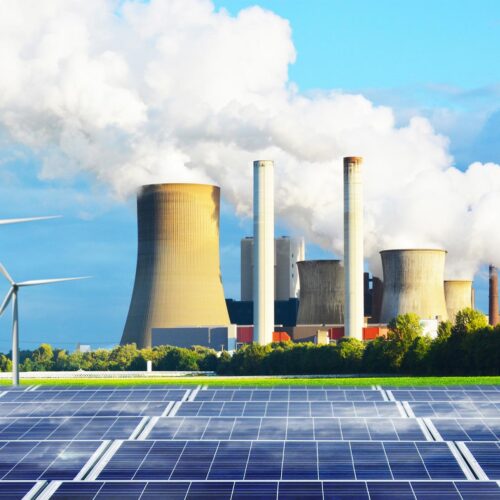Power plant, gas fired power station. Include decreasing chart, graph. Industrial factory may called combined cycle gas turbine plant. Concept for low, loss, drop in electricity energy generation.

The State of Utility Planning, 2025 Q3
Utility resource plans updated in 2025 Q3 reflected the influence of several levels of policy and regulation, leading to significant uncertainty in planning and decisions to delay retirements of existing fossil power plants.
This article is one of a series in our review of all integrated resource plans (IRPs) for electric utilities across the United States. We provide analysis of expected load, planned capacity, modeled generation and emissions, and comparison to targets and decarbonization scenarios to evaluate progress toward a zero-carbon energy future. IRPs do not provide a fully accurate prediction of the future, but we focus on them because they reflect the direction that utilities are currently striving for and a set of proposed actions to get there.
Updates in 2025 Q3
In the third quarter of 2025, utilities that updated their IRPs increased projected load through 2035 by 2.1 percent and emissions by 5.5 percent.
This continues a few trends that we have highlighted in recent quarterly reviews: projected electricity demand is increasing due to new large loads, and many utilities are finding it difficult to meet capacity needs in the near future. Changes to resource adequacy rules, particularly in the Midcontinent Independent System Operator (MISO) region, continued to have an impact, and phase out of renewable tax credits began to appear as an additional reason that many utilities have recently reduced plans to build wind and solar capacity.
New common themes of IRPs this quarter included delayed retirements and uncertainty in planning. Many utilities are experiencing load growth, but don’t have the ability to bring new resources online quickly or rely on purchases from neighboring utilities — available capacity is limited not just for individual utilities, but for broader regions. Consequently, many utilities have pushed back retirement dates for existing fossil plants, expecting this to be the lowest-cost solution to ensure resource adequacy.
Compounding these issues is significant uncertainty in several areas, including load forecasts, resource costs, market rules, environmental protection agency (EPA) regulation, and federal and state policy. Utilities discussed the difficulty of planning with all these sources of uncertainty and change, reflecting that the industry is undergoing an intense period of change and needs to learn new methods to effectively meet the needs of the future grid.
RMI’s Engage & Act Platform: Data and Insights for Real Climate Impact
RMI’s Engage & Act Platform provides data and insights for real climate impact. To learn how you can access and use this targeted resource to uncover recent trends and clean energy growth opportunities — and accelerate the pace of electric utility carbon emissions reductions — please visit the Engage & Act website or email engageandact@rmi.org.
Below, we share detailed analysis of recent changes in IRPs, their underlying causes, and potential opportunities for improvement.
The current state of IRPs
In our current snapshot of IRPs (Exhibit 1), we continue to see a gap between projected emissions, target emissions, and decarbonization pathways such as the International Energy Agency’s Net Zero Emissions by 2050 Scenario (IEA NZE).
Most decarbonization pathways, including the IEA NZE, find that the electricity sector needs to reach net-zero emissions by 2035. Unfortunately, utility company targets often aim for net-zero emissions by 2050 and often do not comprehensively cover emissions from both owned (Scope 1) and purchased (Scope 3) emissions. If all companies in our coverage meet their targets, they will only reduce emissions by 63 percent by 2035, compared to a 2005 baseline. We also find a gap between these targets and projected emissions based on IRPs, which as of 2025 Q3 we project to be reduced by just 53 percent by 2035, compared to a 2005 baseline.
Exhibit 1
Load
As of the end of 2025 Q3, IRPs across the United States anticipate load will grow 24 percent by 2035 compared to 2023 levels (Exhibit 2). This is an increase from prior projections — 12 percent at the end of 2023, 8 percent in August 2022, and 6 percent in January 2021.
Load growth continues to be driven in the short term primarily by large loads such as data centers. This quarter, every utility with a new IRP increased its load forecast compared to previous expectations. Baseline load forecasts included moderate growth, but utilities also consistently reported wide ranges of uncertainty in their forecasts. Santee Cooper’s IRP (Figure 8) is a highlight example, where a range of uncertainty in potential new large loads from 101 to 1,536 MW accounts for a majority of the difference between high and low load cases.
Load changes from residential customers are relatively smoother and more predictable, and recent IRPs expressed more challenges with forecasting large loads and predicting increases in extreme weather events. Best practices for large load forecasting and planning with climate variability are increasingly critical for effective utility decision-making, as both the quantity and hourly profiles of new load are different from past utility experience.
Exhibit 2
Capacity
Current planned capacity in IRPs across the United States (Exhibit 3) includes 259 GW of wind and solar additions, 103 GW of gas additions, and 74 GW of coal retirements between 2023 and 2035.
This reflects 6 GW of additional wind and solar capacity (+1 GW from 2025 Q2), 53 GW of additional gas capacity (+4 GW from 2025 Q2), and 7 GW (+0 GW from 2025 Q2) of additional coal retirements compared to utility plans at the end of 2023.
Utilities that updated IRPs in 2025 Q3 cited several external factors with influence on their capacity plans:
- This is the first quarter in which we observed impact of the phase out of federal renewable tax credits, leading to higher costs and reduced plans to build wind and solar capacity.
- MISO’s shift to seasonal accreditation had varying impacts on utility plans, generally resulting in shifts toward gas capacity as a safe, familiar solution for meeting capacity needs.
- Compliance with EPA regulation of greenhouse gases often led to gas cofiring as an option with minimal risk if the regulation is rescinded.
- Difficulty interconnecting new resources in MISO, with impacts both locally and regionally, made it difficult to rely on power purchases for capacity needs.
- Renewable portfolio standards in New Mexico helped maintain and accelerate El Paso Electric’s plans to build zero-carbon capacity.
- Frequency of extreme weather events increased capacity needs to maintain reliability.
The most notable combined effect of these influences was delayed retirements of existing fossil plants, often with conversion from solid fuels to gas. This method provided risk mitigation amid uncertainty and changes, but exposes utilities to gas price volatility and misses the opportunity to reduce emissions and customer costs with zero-carbon electricity generation.
One highlight in this quarter’s capacity plans is Cleco Power’s use of MISO’s generator replacement process to add 240 MW using existing interconnection rights at the site of the retired Dolet Hills coal plant. This example could be scaled to many more opportunities of clean repowering.
Exhibit 3
Emissions
Our latest projections (Exhibit 4) from IRPs at the end of 2025 Q3 are that carbon emissions will be 53 percent lower than 2005 levels by 2035. This is a smaller reduction than we projected from IRPs in August 2022, when emissions planned in IRPs showed a 57 percent reduction. And it is nearly back to the level we projected at the beginning of 2021 when the figure was 51 percent.
Projected emissions are lower than today’s emissions because utilities do still have plans to retire coal and build zero-carbon capacity. However, projected emissions have consistently increased since the end of 2024 because of increased electricity demand, insufficient zero-carbon capacity additions to meet all of this demand, and increased use of gas generation to fill the remaining gap.
All utilities that updated their IRPs in 2025 Q3 increased their future projected emissions compared to previous plans.
Exhibit 4
Cumulative metrics
When considering climate alignment of the US electricity sector, or individual utilities, RMI’s Engage & Act platform’s key metric is cumulative emissions through 2035. Cumulative emissions, or the total amount of greenhouse gases put into the atmosphere, directly influences climate change, so this metric gives us clear insight into whether we are on track to meet climate goals. We also find value in metrics of cumulative projected load, to know whether the task of reducing emissions is becoming easier or more difficult for utilities, and cumulative projected emissions intensity, to know if consumers are increasing or decreasing emissions associated with their electricity consumption.
Exhibit 5 shows that across all IRPs in the United States, cumulative projected emissions from 2023 to 2035 are 4.9 percent higher, cumulative projected load is 2.2 percent higher, and cumulative projected emissions intensity is 2.7 percent higher now at the end of 2025 Q3 compared to a year ago at the end of 2024 Q3.
Exhibit 5
Exhibit 6 provides an additional view of the direction that IRPs are going, by considering percent change in cumulative projected load and emissions among the set of companies that did update their IRPs each quarter. Utilities that updated IRPs in 2025 Q3 increased load by 2.1 percent, emissions by 5.5 percent, and emissions intensity by 3.3 percent.
In our history of tracking IRPs, load projections have never decreased in a quarter, and 2025 Q3 makes nine consecutive quarters of at least 2.1 percent load growth among utilities with IRP updates. While projected emissions decreased in the early 2020s, 2025 Q3 also marks seven consecutive quarters of at least 3.2 percent increase to projected cumulative emissions among companies with IRP updates.
Exhibit 6
Achieving a climate-aligned future
Electric utilities in the United States face significant, and changing, challenges. They remain focused on providing reliable electricity service to customers while balancing priorities of costs for customers, external requirements of policy and regulations, returns to investors, and climate impact.
Current planning processes struggle to meet these needs. Current utility plans do not reduce emissions fast enough to align with decarbonization targets. Multiple priorities can appear to conflict with each other.
However, some interventions to utility planning have synergistic effects in solving multiple problems simultaneously. Improved forecasting of large loads and planning for climate variability, understanding that reliability and dispatchability are not the same, and updated costs and constraints of available technologies are key. While delayed retirements and more gas additions are the default choice in most current utility plans, there are a range of fast, affordable, flexible alternatives that utilities can use in this period of transition. Improved planning processes, with supporting policy and regulation, would enable utilities to more effectively transition toward a low-cost, zero-carbon future.
Methodology
Historical data in this article comes from the RMI Utility Transition Hub. Projected capacity and total generation (load) is based on data collected manually from IRPs by EQ Research, with RMI corrections, combined with historical data. Generation by technology is calculated with assumed continuation of trends in capacity factor for each company and technology, and is converted to emissions using utility-specific emissions factors by technology.

